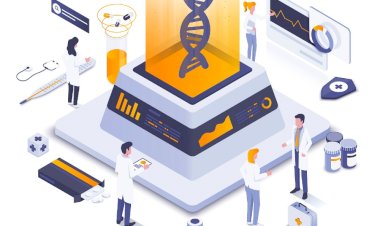What is Exonum and how it can used for Healthcare system?
Exonum is a blockchain technology that allows businesses, governments, and organizations to access the benefits of blockchain without developing a blockchain in-house.

Exonum is a blockchain technology that allows businesses, governments, and organizations to access the benefits of blockchain without developing a blockchain in-house. The Amsterdam-based development team has created a highly secure, Byzantine consensus-based blockchain that supports smart contracts. The blockchain is adaptable to a wide range of uses case — including everything from government registries to e-voting to supply chain management
The name “Exonum”, by the way, comes from the word Exonumia, which refers to “items representing value that are traditionally used to engage in a diverse marketplace.” The company chose the name Exonum “because you can use it to represent, store, exchange and secure anything of value — any digital asset.”
Exonum uses the Rust programming language at its core “to achieve top-notch level of security, performance and concurrency”, explains the official website. Rust is known for its speed and security.
Exonum works in a similar way to other blockchain technology. It’s a decentralized database where records are kept in an immutable, easily auditable way. There’s no centralized server for hackers to target, and there’s no way to change records once they’ve been entered into the blockchain.
One of the key innovations with Exonum is its consensus algorithm. Exonum uses a custom-built Byzantine consensus algorithm that keeps your data safe without needing to mine blocks — even in cases where nodes malfunction or become susceptible to bad actors. Exonum remains secure even when many nodes are compromised. The blockchain will remain functional even if up to 1/3 of all nodes in the blockchain network are offline or compromised
Exonum’s blockchain can handle up to 3,000 transactions per second (Within a global, distributed network), providing a clearing latency of 2.5 seconds. Exonum can handle up to 15,000 TPS in custom cases (i.e. within a corporate network and not worldwide).
Another key innovation with Exonum is the light client. Exonum has published its complete library of code online, including the client-side software clients can use to manage the blockchain. That client uses JavaScript, which makes it easy to port clients to browser, desktop, and mobile environments.
With that introductory details let see how an Exonum blockchain can rapidly work on processing of medical data and protect this delicate data from illegitimate access and theft.
Classified medical information
Today, the digitization of medicine enables all participants in the healthcare system, from patients to pharmaceutical companies, to exchange data in electronic form
For example, E electronic Medical Records (EMR) have made it easier for doctors and patients to access their medical history. Solutions like these are being used successfully in Taiwan and Estonia. EMRs open up new possibilities in healthcare, but they also require new approaches to ensure personal data security.
Data on human health is highly sought-after by cybercriminals. According to a Ponemon Institute study from 2016, 89% of medical organization managers surveyed admitted they had experienced at least one leak in the last couple of years. State organizations like the U.S. Department of Health and Human Services (HHS) and laws like the Health Insurance Portability and Accountability Act of 1996 (HIPAA) advise on how to protect medical records but leaks often happen anyway.
Blockchain can help solve the problem of personal data security in medicine. Distributed registries can formalize the process of exchanging medical records and give patients more control over their health indicators.
An Exonum-Based Medical Ecosystem
Ideally medical ecosystem consists of a blockchain and cloud storage. Small files with medical data are stored in the blockchain, and large files are stored in the cloud. The blockchain records information about the data uploaded to the cloud, the rights to read them, and information about the key custodians.
Any company can act as a cloud storage provider (the main thing is that the service meets the requirements of HIPAA).The plan is to store volumetric medical data there, for example, CT or MRI images, which can occupy tens of megabytes. All data uploaded to the cloud is encrypted.
Making medical ecosystem into four user groups:
· Users (patients) — patients themselves or authorized third parties (medical centres, for example) who upload medical data to the system.
· Validators — check the quality and authenticity of user-uploaded data.
· Clients (doctors) — examine patient data, prepare health status reports.
· Pharmaceutical and biotechnology companies or research institutes — may acquire access to anonymised user data.
Data Processing
The first step is when the user uploads their data to the cloud, where it is checked and anonymised — the patient ID is removed — and then encrypted using symmetric encryption. Then, using the Shamir algorithm, the keys are sent to the custodians (a kind of full blockchain node) via direct authenticated communication channels, so that they can decrypt the user data if necessary.
At the same time, a service transaction is generated, which informs other ecosystem participants about data being uploaded to the cloud. This transaction contains the public key, information about the type of data and a link to it in the cloud. After an electronic signature, information can be recorded in the blockchain.
Network participants decide whether to add a transaction to the blockchain, with the help of a consensus algorithm. The validator nodes check the information and generate a service transaction containing data hashes and the result of the validation. Once the data is validated, it is recorded in the blockchain. Information about the patient then becomes available to other participants.
Then, if the doctor needs the data for research or to make a diagnosis, he fills out a request and sends it to the validators. They add the request to the blockchain and tell the custodians to send cryptographic keys to the doctor to decrypt the data from the cloud. The process is the same for pharmaceutical companies, research institutes, government medical institutions, and supervisory authorities.
Next Steps
The Exonum blockchain can become a single (but decentralized) database for medical information. In the future, it will be filled not by doctors who contribute data from electronic records, but also by medical IoT gadgets. In the blockchain, you can also record the results of group examinations from diagnostic centres and information on clinical drug trials.
Every hospital in the network (country-wide, system-wide, etc.) will receive authorized access to patient data. This will enable doctors to quickly share the results of clinical trials, which will accelerate the development of drugs for serious diseases
Some components of ecosystem have already been successfully tested in practice; we have created the first private blockchain based on Exonum for the exchange of medical data in the field of radiology. This solution simplifies the work of radiologists, reducing times for analysis of images and providing access to a single database for research.
We hope that with the help of our medical ecosystem, clinical patients in the future can track their doctor visits and medical services, monitor changes in their health and assess the impact of drugs the doctor has prescribed. A single blockchain-based ecosystem will help speed up the diagnosis of diseases, reduce errors in diagnosis and make the treatment process more transparent.

 Meghana
Meghana 


































